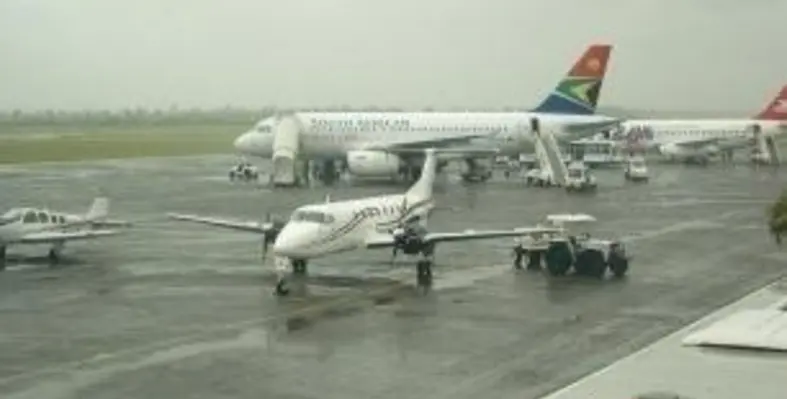Sub-Saharan Africa reacts to rising air cargo volumes
Angola’s President Jose Eduardo dos Santos made a point of officially opening the newly refurbished “Presidential Complex” at Luanda’s February 4th Airport. The plush and polished facility for the today’s and future heads of state was approved, and the replacement of former 1980s’-era furnishings was deemed money well spent.
What makes this relatively trivial incident noteworthy was its symbolism as one ceremony amongst hundreds taking place throughout Africa this year as the continent becomes aggressive about improving its aviation infrastructure. Air passenger travel is rising and air cargo volumes, currently flat this recessionary year, are expected to rebound.
New terminal
Zambia National Airports Corporation (NACL) has accepted the recommendations of a US-funded survey of national air infrastructure needs through 2029 done by consultancy group LeighFisher and which emphasized rehabilitation of the Lusaka airport, into which feed Zambia’s three other international airports. First order of business is a new $200mn terminal for Lusaka. With five new carriers landing at Lusaka since the start of 2011 and cargo volumes expected to rise, terminals that have long exceeded their usefulness will have to be replaced. NACL sites cargo handling facilities as in need of urgent upgrade with Lusaka increasingly utilized for in-transit cargo to the copper belt and other destinations.
Down at Livingston near the Victoria Falls tourism magnet, nearly half the work has been done on a $12mn rehabilitation of the international airport. Passenger capacity will be boosted from today’s 250,000 to an eventual 899,000. The current terminal will be relegated to domestic use when a new terminal for international flights is completed.
Tanzanian conference
On the opposite coast, Tanzania hosted this year’s 17th African Aviation and Allied Business Conference in August, where delegates heard repeated calls from air industry players and government officials for more investment in national and regional air infrastructure if air passenger and cargo volumes were to realize their full potential.
“The industry needs heavy investment which the governments alone cannot manage. African governments cannot succeed in the aviation industry without private sector’s support,” Tanzanian President Jakaya Kikwete told more than 200 delegates.
One Tanzanian airline official blamed bad national air infrastructure of his aircrafts’ inability to do half the work of which they are capable.
But conference attendees also heard upbeat updates on air infrastructure projects in the works or on the drawing board. In Tanzania, for instance, with traffic volumes up 10 per cent over last year, government has raised along with private partners $68m for airports rehabilitation projects.
Nigeria - changes required
Nigeria needs not only a desperate upgrade of air freight facilities, but “state of the art facilities” compatible to the value of rising and increasingly specialized cargoes, according to Nigeria’s Airfreighters Stakeholders Association. Air cargo regulations are “obsolete” and round the clock customs clearance is now necessary at all airports, the group said while calling on its government to take the air cargo sector seriously.
When direct flights between Luanda and Lagos commenced in September after two years of government to government negotiations, pressure mounted in the Nigerian media and business sector to privatize the country’s airports for greater efficiency.
2011 has found Rwanda leave the “virtual” airline business and entering the real thing, evidenced by a pair of new Boeing 737-800 aircraft outfitted with luxury features and delivered in August and October.
New routes
“Before, we only carried a national flag,” admitted RwandAir CEO John Mirenge to explain his company’s previous lack of not only aircraft but pilots and engineers. The airline leased aircraft. The Boeings each have a seating capacity of 154, and have sparked the airline’s ambition to increase its route. Centrally located Rwanda is within two or three hours flying distance from many African capitals. Recognising this, Turkish Airlines will introduce service to Kigali in April 2012.
But such ambitions require ground infrastructure, in Rwanda as elsewhere. By December, government will decide on a private partner to develop a new international airport with a capacity to handle three million passengers, ten times the number of Kigali’s current international airport. Planners want the region’s longest runway to accommodate the largest-bodied aircraft, and for air freight handling capacity to double, from 7000 tonnes that is the current annual movement to 15 500 tonnes by 2025.
Bulk purchasing?
Small volumes purchased and weak negotiating power of African air carriers have made aviation fuel prices more costly on the continent, dragging down the air carriers’ profitability in recent years. Relief may be at hand in 2012 with a plan by the African Airlines Association (AFRAA) to lower costs by purchasing in bulk on behalf of member air carriers. Also on AFRAA’s lobbying agenda with the governments of their constituent carriers are ground infrastructure improvements.
The value of human capital as a component of Africa’s aviation infrastructure is also understood. And at the Tanzanian air conference, delegates noted the trend of Middle-Eastern and Asian air carriers and aviation firms “poaching” skilled African aviation experts.
In August, the East African Countries (EAC) sent aviation officials to Kigali to facilitate the harmonization of cargo tariff and passenger ticket prices amongst the EAC, with the goal of reducing prices and boosting air traffic passenger and cargo volumes.
Once the key airport upgrades are accomplished, aviation experts anticipate regional and intercontinental air carriers to proceed with a “natural selection” to determine which locations gain the cultivated status of regional hub.
“Every country wants to be its region’s air hub. Lagos, Nigeria; Kigali, Rwanda; Luanda, Angola; Johannesburg, South Africa; Nairobi, Kenya, Cairo, Egypt – these are the present and likely future hubs. But many factors determine the success of a location. We can expect competition. At present the money being spent on airport projects is seen as a wise investment,” said Thomas Mlindza, an aviation business consultant based in Maputo, where Mozambique’s capital city airport is also undergoing a significant upgrade.






